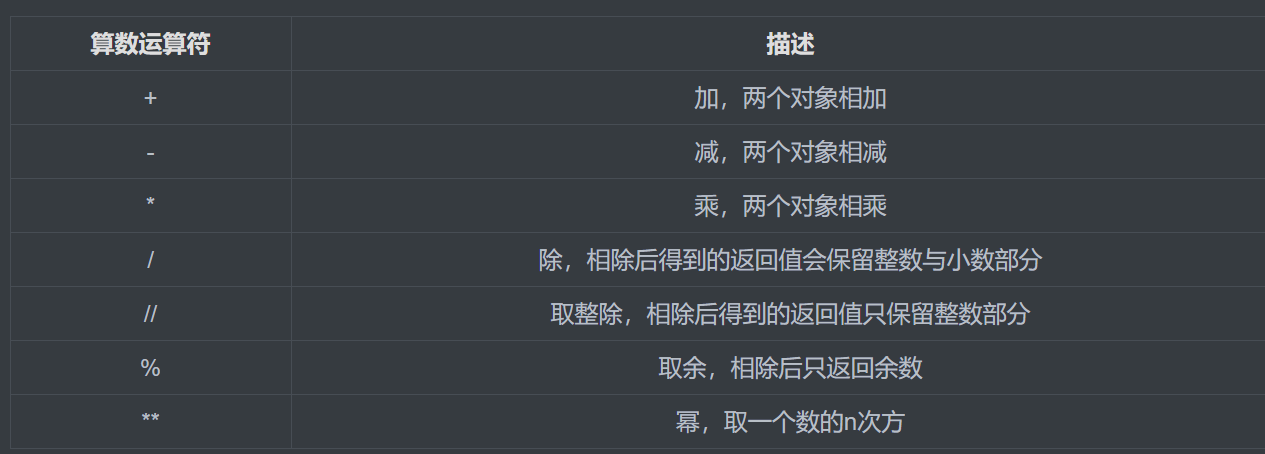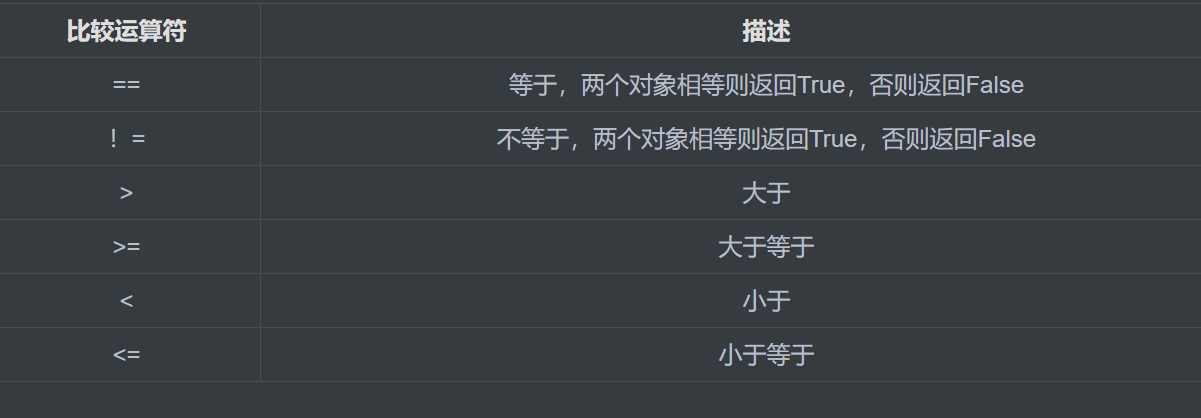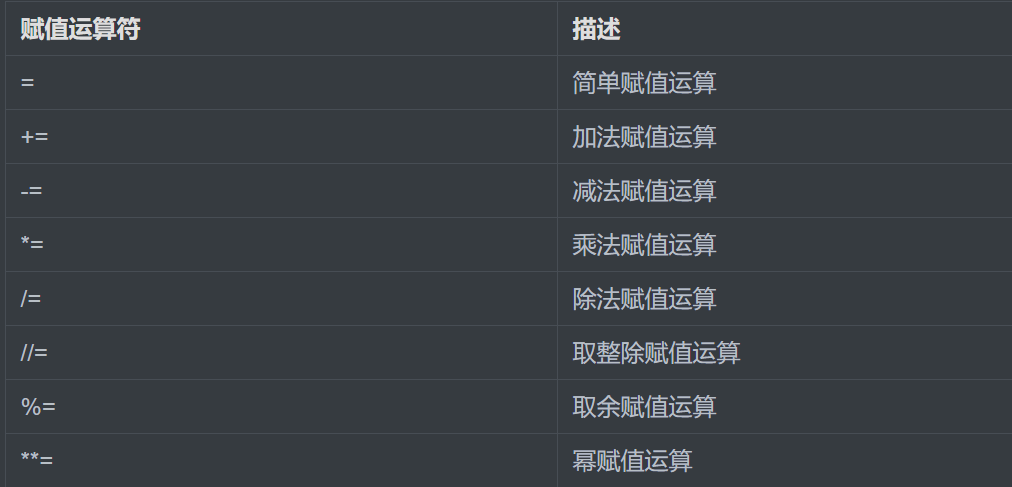python语法入门之与用户交互以及运算符
与用户交互

1、什么是用户交互
用户交互就是人往计算机里输入数据,计算机输出的结果
2、为什么要与用户交互
为了让计算机能够像人一样与用户沟通交流
3、怎么使用

3.1、输入(input)
username = input('请输入您的用户名:')
#解释:将input获取到的用户输入绑定给变量名username,并且input获取到的用户输入全部都会转换成字符串
3.2、输出(print)
1、格式为print(),其中打印多个元素时,需要用逗号隔开。
2、默认print功能有一个end参数,该参数的默认值为“\n”(代表换行),可以将end参数的值改成任意其他字符
print('hello',end='') print('world') #得到helloworld print('hello',end='*') print('world') #得到hello*world
格式化输出
1、概念
将字符串中某些内容替换掉再输出就是格式化输出
2、使用
占位符%s:表示可以接受任意类型的值
占位符%d:只能接受数字
使用方式为:先使用占位符占位,在使用%按照位置一一替换
参考一
name = input("name:") age = input("age:") sex = input("sex:") job = input("job:") msg = """ name : %s age : %s sex : %s job : %s """ print(msg% (name, age, sex, job))
参考二
res = '亲爱的%s你好!你%s月的话费是%s,余额是%s' print(res % ('tom', 11, 100, 0)) print(res % ('jon', 11, 300, 20)) print(res % ('jake', 11, 500, -20))
基本运算符
算术运算符

比较运算符

赋值运算符
1、增量运算符

2、链式赋值
x=10 y=10 z=10 x=y=z=10
3、交叉赋值
m = 1 n = 2 #m和n的值做交换 #方法一: x = m m = n n = x print(m,n) #得出m=2,n=1 #方法二: m,n = n,m print(m,n) #得出m=2,n=1
4、解压赋值
muns = [111, 222, 333, 444, 555] # 常规操作 a = muns[0] b = muns[1] c = muns[2] d = muns[3] e = muns[4] # 解压赋值 a, b, c, d, e, = muns[0][1][2][3][4] # 进阶 a, *_ = muns a, *_, e = muns
注:当元素比较多,而我们只想取一两个值时,可以用 *_ 匹配
字符串、字典、列表、元组、集合类型都支持解压赋值
逻辑运算符

注:当三个逻辑运算符混合使用时,是有优先级的。三者的关系是not>and>or,同一级默认从左往右计算。但是我们在编写的时候最好人为的规定好优先级
连续多个and
2 > 1 and 1 != 1 and True and 3 > 2 # 判断完第二个条件,就立即结束,得的最终结果为False False
连续多个or
2 > 1 or 1 != 1 or True or 3 > 2 # 判断完第一个条件,就立即结束,得的最终结果为True True
三个混合使用
3>4 and 4>3 or 1==3 and 'x' == 'x' or 3 >3 False (3>4 and 4>3) or (1==3 and 'x' == 'x') or 3 >3 False
成员运算

注意:虽然下面两种判断可以达到相同效果,但是推荐使用第二种,因为not in语义更加明确
not 'lili' in ['jack','tom','robin'] True 'lili' not in ['jack','tom','robin'] True
身份运算
判断两个数据,值和内存地址是否相等。其中符号==只判断值,is判断内存地址

注意:值相等内存地址不一定相等,内存地址相等值一定相等






【推荐】国内首个AI IDE,深度理解中文开发场景,立即下载体验Trae
【推荐】编程新体验,更懂你的AI,立即体验豆包MarsCode编程助手
【推荐】抖音旗下AI助手豆包,你的智能百科全书,全免费不限次数
【推荐】轻量又高性能的 SSH 工具 IShell:AI 加持,快人一步
· 10年+ .NET Coder 心语,封装的思维:从隐藏、稳定开始理解其本质意义
· .NET Core 中如何实现缓存的预热?
· 从 HTTP 原因短语缺失研究 HTTP/2 和 HTTP/3 的设计差异
· AI与.NET技术实操系列:向量存储与相似性搜索在 .NET 中的实现
· 基于Microsoft.Extensions.AI核心库实现RAG应用
· TypeScript + Deepseek 打造卜卦网站:技术与玄学的结合
· 阿里巴巴 QwQ-32B真的超越了 DeepSeek R-1吗?
· 【译】Visual Studio 中新的强大生产力特性
· 10年+ .NET Coder 心语 ── 封装的思维:从隐藏、稳定开始理解其本质意义
· 【设计模式】告别冗长if-else语句:使用策略模式优化代码结构